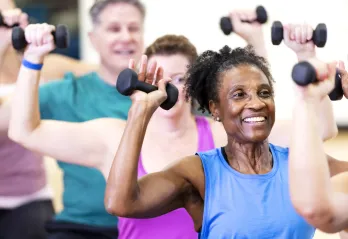Burning Calories and Increasing Metabolism: Cardio and Strength Training

When I visit YMCA of Bucks and Hunterdon Counties Wellness Centers, I cannot help but notice the ways our members spend their workout time. Everyone is in a different stage of their wellness journey. Some are on treadmills prodigiously hiking uphill, while others are repping isolated muscle groups on weight machines, such as the biceps curl or leg press. A question often floating above fitness communities is how to achieve optimal weight or fat loss, and what types of exercise will best sustain that loss? Is it long sessions of cardio? And what about increased metabolism through weight training?
Time spent researching these questions on the internet will yield a wide and somewhat varied array of answers. However, most credible sources agree on some very common principles.
Calorie deficit means everything for fat and weight loss. Whether you work out once a week or every day, loss-seekers should have a general, if not detailed understanding of calorie intake. Certainly, if you are exercising moderately-to-vigorously multiple times per week, be it cardio or strength training, calories are being burned and your likelihood of creating that calorie deficit goes up. However, people tend to overestimate the number of calories they burn in a workout and underestimate the number of calories they consume. Nutrition is key when working towards fat loss, muscle gain, or body recomposition goals. Generally speaking, a diet that is higher in protein and vegetables, especially leafy greens, and includes a balance of healthy fats and complex carbohydrates with minimal refined sugar will support the weight loss or fat loss goals when combined with regular exercise. No surprises there.
Moderate to vigorous cardiovascular exercise burns calories quickly. Steady-state jogging, running, elliptical and stationary bike workouts offer efficient calorie-burning opportunities to support weight or fat loss. Again, no surprises. However, what is less commonly known is that once the cardio workout ends, and the heart rate comes down, so does the workout-driven calorie burn. Strength training, such as lifting weights, muscle resistance exercises, or even body-weight supportive calisthenics, such as pushups, builds muscle, increases your heart rate again during exercise, and sheds fat. As body composition begins to slowly shift to a higher percent muscle mass and lower percent body fat the body’s metabolic rate increases, therefore slightly increasing the body’s ability to burn calories while at rest. But only slightly, though, because that long-term difference in metabolism is not overly significant.
More significant, however, is research shows metabolism and calorie-burning continue to be elevated for hours immediately following strength training. This is not to be confused with the long-term permanent metabolism that grows only slightly, as noted in the previous paragraph. Rather, in the immediate hours following strength training sessions, the body continues to burn calories at an elevated workout rate, and gradually slows over time. Some cases have shown metabolism to remain elevated for up to 38-72 hours following strength training. This is really where strength training appears to most support fat loss. Again, with cardio, the calorie burn rate decreases as the heart rate decreases immediately following a good run, jog or bike. Also important to note, if performing more of a fast paced circuit style or HIIT style training, which would be metabolic training or metabolic conditioning, the combination of exercises, whether they be strength or cardio performed at higher intensity levels with minimal periods of rest in between exercises, is also a great way to continue to burn calories more efficiently both during and after your workouts, sometimes as long as 48 hours+.
So supplementing one’s cardio workouts with moderate-to-vigorous strength training, such as pull-ups, loaded bodyweight squats and lunges or bench presses, not only replaces fat with muscle, but supports the calorie burn for hours beyond the workout. There is no question that a balanced, protein and vitamin-rich diet, coupled with regular cardio and strength-building exercise, supports healthy living. But now we know a little bit more about the value of strength training and muscle building. Keep in mind, also, that muscle is denser than fat, so you may be doing it right, but not see the big difference on the scale. Remember, all bodies are different. If you feel good, and notice improvement in other ways, including confidence and better quality sleep, along with having more energy, keep it going. Everything’s right.
About the Author
 Andrea Brown is Vice President of Health and Wellness for YMCA of Bucks and Hunterdon Counties. Andrea earned a BA in Marketing from The College of New Jersey in 2004 and has over ten years of experience in the health and wellness industry as an American Council on Exercise Certified Personal Trainer, Group Fitness Instructor and holds a number of specialty certifications including Functional Training, Fitness Nutrition, Precision Nutrition Level 1 Nutrition Coach. Andrea has served the YMCA community since 2012.
Andrea Brown is Vice President of Health and Wellness for YMCA of Bucks and Hunterdon Counties. Andrea earned a BA in Marketing from The College of New Jersey in 2004 and has over ten years of experience in the health and wellness industry as an American Council on Exercise Certified Personal Trainer, Group Fitness Instructor and holds a number of specialty certifications including Functional Training, Fitness Nutrition, Precision Nutrition Level 1 Nutrition Coach. Andrea has served the YMCA community since 2012.
Resources
Online resources provided are not the only resources that exist on these topics, and some websites contain ads and pop-ups. YMCA of Bucks and Hunterdon Counties is not affiliated with advertisers on third party web pages, and responsibility for results of clicking through third party websites is the responsibility of the user.